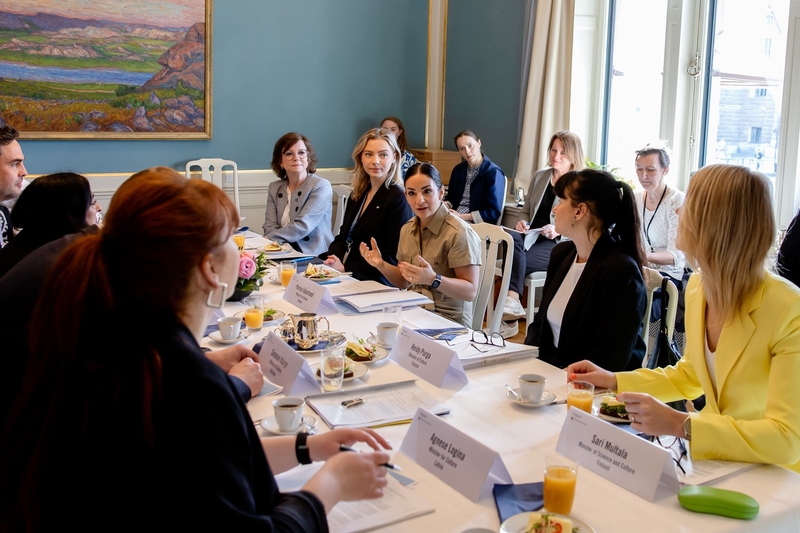
Culture and Cultural Heritage: A Priority for Nordic and Baltic Ministers for Culture

In today’s world, characterized by geopolitical tensions, crises, and conflicts in neighboring countries, the protection and preservation of culture and cultural heritage have become increasingly crucial. Recognizing the significance of this issue, the Nordic and Baltic ministers for Culture recently convened to address the challenges and explore collaborative solutions.
Emphasizing the Importance of Cultural Resilience
The ministers unanimously agreed that culture plays a vital role in building democratic and resilient societies. In times of crisis, high alert, or war, it becomes even more imperative to safeguard cultural heritage and maintain cultural activities. The current situation demands immediate action and heightened preparedness in the cultural sector.
Parisa Liljestrand, Sweden’s Minister of Culture and the chair of the Nordic ministers for culture, highlighted the urgency of the matter. “The pressing need to protect cultural heritage and sustain cultural activities cannot be overstated. As our societies face unprecedented external pressures, it is crucial that we come together, share our experiences, and develop effective strategies to address these challenges,” she stated.
Collaborative Efforts for Cultural Preparedness
The ministerial meeting served as a platform for exchanging valuable experiences and knowledge among the Nordic and Baltic countries. The discussions focused on identifying ways to enhance preparedness in the cultural sector and strengthen cooperation in the face of external threats.
Recognizing the Sustainable Development Goals (SDGs) as a guiding framework, the ministers emphasized the relevance of SDG 11: Sustainable Cities and Communities, and SDG 16: Peace, Justice, and Strong Institutions. These goals provide a comprehensive framework for promoting cultural resilience and protecting cultural heritage in times of crisis.
Conclusion
The Nordic and Baltic ministers for Culture have reaffirmed their commitment to protecting cultural heritage and promoting cultural activities in the face of adversity. By joining forces and sharing expertise, they aim to strengthen cultural resilience and enhance preparedness in the cultural sector. The Sustainable Development Goals serve as a guiding framework, ensuring that their efforts align with global aspirations for sustainable development and peace.
SDGs, Targets, and Indicators
1. SDGs Addressed or Connected to the Issues Highlighted in the Article:
- SDG 16: Peace, Justice, and Strong Institutions
- SDG 11: Sustainable Cities and Communities
- SDG 3: Good Health and Well-being
2. Specific Targets Based on the Article’s Content:
- Target 16.7: Ensure responsive, inclusive, participatory, and representative decision-making at all levels
- Target 11.4: Strengthen efforts to protect and safeguard the world’s cultural and natural heritage
- Target 3.d: Strengthen the capacity of all countries, in particular developing countries, for early warning, risk reduction, and management of national and global health risks
3. Indicators Mentioned or Implied in the Article:
- Indicator 16.7.1: Proportions of positions (by sex, age, persons with disabilities, and population groups) in public institutions (national and local legislatures, public service, and judiciary) compared to national distributions
- Indicator 11.4.1: Total expenditure (public and private) per capita spent on the preservation, protection, and conservation of all cultural and natural heritage, by type of heritage (cultural, natural, mixed, and World Heritage Centre designation), level of government (national, regional, and local/municipal), type of expenditure (operating expenditure/investment) and type of private funding (donations in kind, private non-profit sector, sponsorship, and others)
- Indicator 3.d.1: International Health Regulations (IHR) capacity and health emergency preparedness
Table: SDGs, Targets, and Indicators
| SDGs | Targets | Indicators |
|---|---|---|
| SDG 16: Peace, Justice, and Strong Institutions | Target 16.7: Ensure responsive, inclusive, participatory, and representative decision-making at all levels | Indicator 16.7.1: Proportions of positions (by sex, age, persons with disabilities, and population groups) in public institutions (national and local legislatures, public service, and judiciary) compared to national distributions |
| SDG 11: Sustainable Cities and Communities | Target 11.4: Strengthen efforts to protect and safeguard the world’s cultural and natural heritage | Indicator 11.4.1: Total expenditure (public and private) per capita spent on the preservation, protection, and conservation of all cultural and natural heritage, by type of heritage (cultural, natural, mixed, and World Heritage Centre designation), level of government (national, regional, and local/municipal), type of expenditure (operating expenditure/investment) and type of private funding (donations in kind, private non-profit sector, sponsorship, and others) |
| SDG 3: Good Health and Well-being | Target 3.d: Strengthen the capacity of all countries, in particular developing countries, for early warning, risk reduction, and management of national and global health risks | Indicator 3.d.1: International Health Regulations (IHR) capacity and health emergency preparedness |
Analysis:
The article highlights the importance of protecting cultural heritage and maintaining cultural activities in times of crisis, high alert, or war. This aligns with SDG 16, which focuses on peace, justice, and strong institutions. Target 16.7 specifically emphasizes the need for responsive, inclusive, participatory, and representative decision-making at all levels, which is relevant to the article’s discussion on protecting cultural heritage during times of external pressure.
The article also mentions the Nordic and Baltic ministers for Culture discussing how to work together to step up preparedness in the cultural sector. This relates to SDG 11, which aims to create sustainable cities and communities. Target 11.4 calls for strengthening efforts to protect and safeguard the world’s cultural and natural heritage, which is directly relevant to the article’s focus on protecting cultural heritage during crises.
Additionally, the article briefly mentions the importance of maintaining cultural activities during times of crisis, which can contribute to good health and well-being. This connects to SDG 3, which focuses on promoting good health and well-being for all. Target 3.d emphasizes the need to strengthen the capacity of all countries for early warning, risk reduction, and management of health risks, which can be applied to the article’s context of maintaining cultural activities during crises.
Source: norden.org







